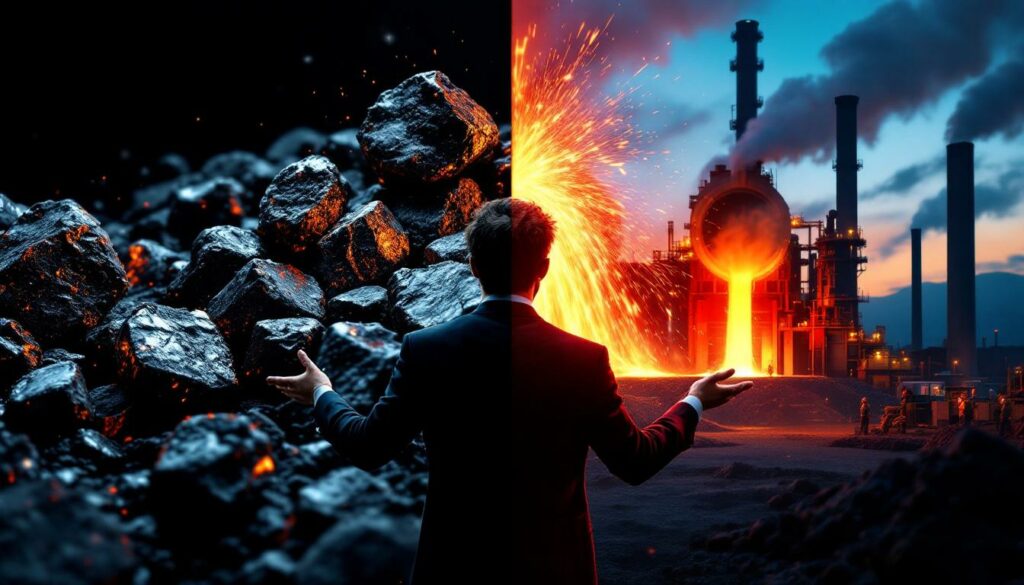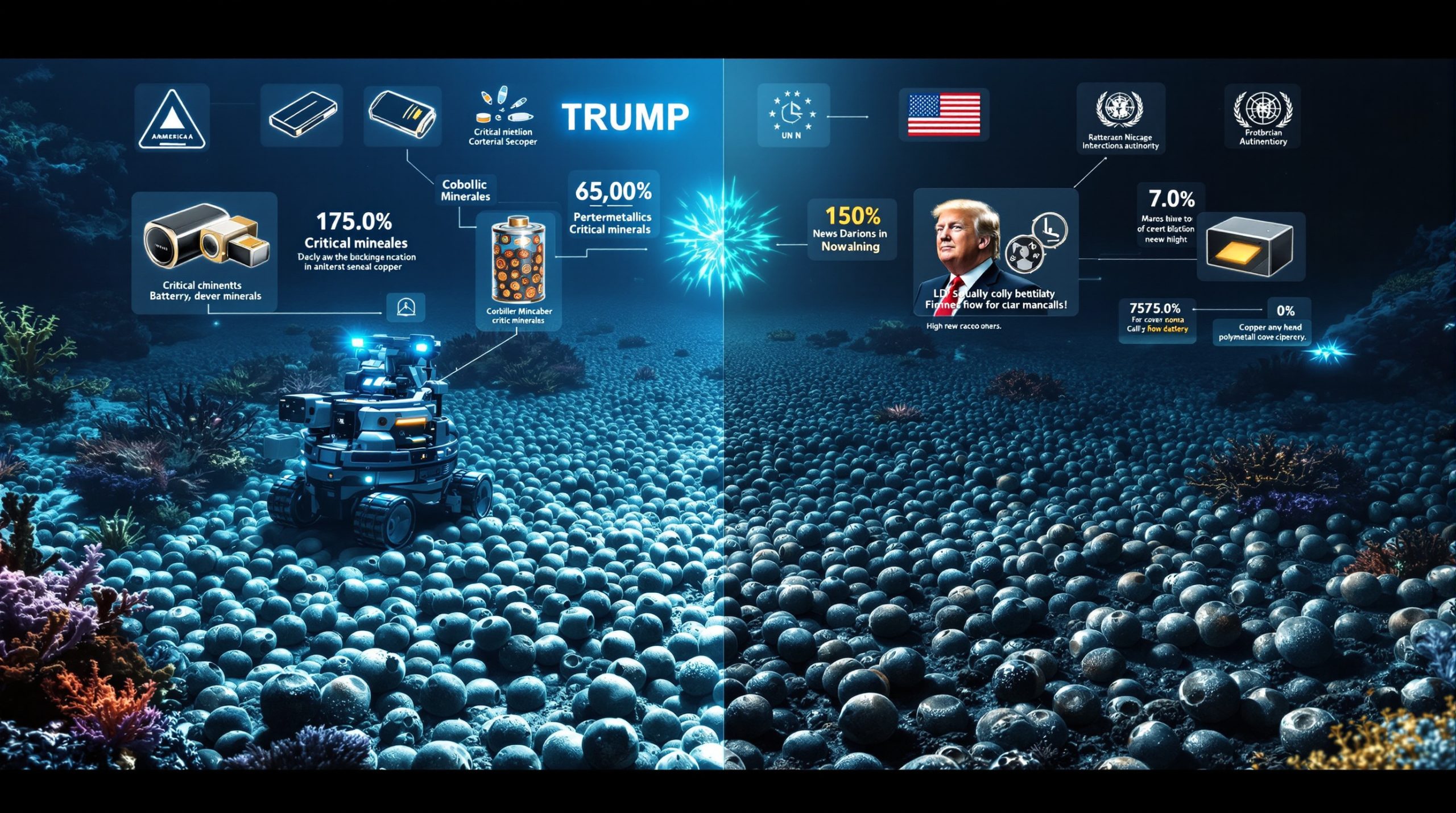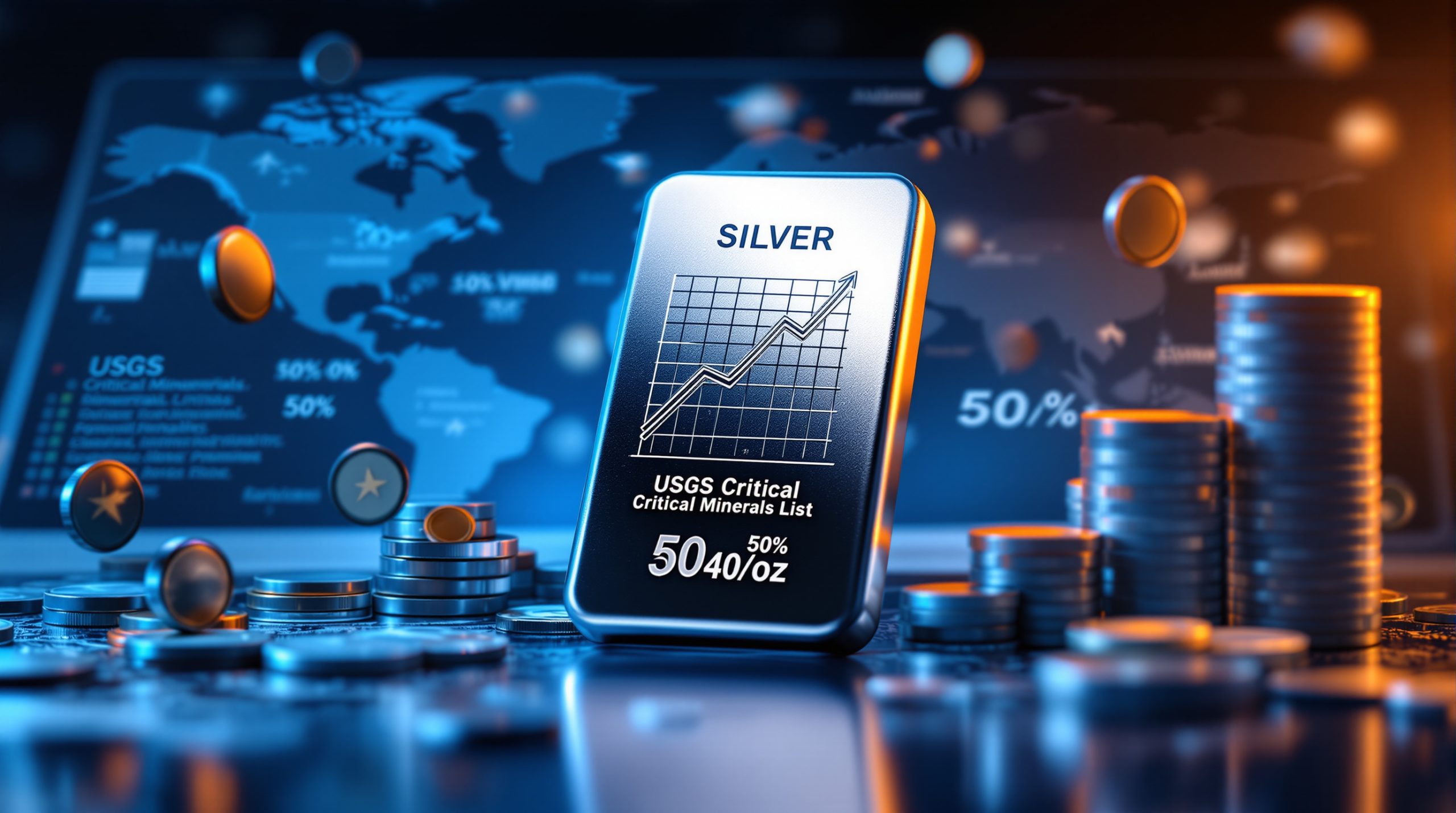What Is Metallurgical Coal and Why Does It Get a Tax Break in Trump's Bill?
Metallurgical coal, often called "met coal" or "coking coal," plays a crucial role in steel production that distinguishes it from its thermal counterpart. Unlike thermal coal used for electricity generation, metallurgical coal serves as an essential ingredient in creating coke—a purified carbon material that provides both heat and chemical reactions necessary for transforming iron ore into steel.
The recent inclusion of metallurgical coal in President Trump's tax legislation represents a significant shift in energy and industrial policy. The bill provides substantial tax advantages to metallurgical coal producers at a time when traditional coal sectors face economic pressures and environmental scrutiny.
This specialized coal category has received preferential treatment based on its classification as a "critical mineral"—a designation typically reserved for materials essential to national security or advanced technology manufacturing. Industry advocates argue the tax break will strengthen American manufacturing and energy independence, while critics question both the environmental implications and economic rationale.
Industry Perspective: "Metallurgical coal is fundamentally different from thermal coal—it's not just a fuel but a crucial raw material for steel production that currently has no commercially viable substitute at scale," notes the National Mining Association in their support for the designation.
The tax advantage comes amid complex market dynamics, with U.S. metallurgical coal producers increasingly dependent on export markets, particularly in Asia. This global dimension adds layers of complexity to the Trump critical minerals order potential impacts on domestic manufacturing, international trade, and climate objectives.
How Does the New Tax Credit for Metallurgical Coal Work?
Understanding the 2.5% Advanced Manufacturing Production Tax Credit
The cornerstone of the new tax benefit is the Advanced Manufacturing Production Tax Credit, which allows metallurgical coal producers to claim a credit worth 2.5% of their production costs. This provision was included in what's been dubbed the "One Big Beautiful Bill"—a comprehensive tax package that contains numerous industry-specific provisions.
The tax credit became possible after a specific sequence of administrative decisions in 2025. In April, President Trump signed executive orders directing Energy Secretary Chris Wright to evaluate whether metallurgical coal should be classified as a "critical mineral." By May 2025, Secretary Wright made the official determination, effectively opening the door for the tax credit's application to metallurgical coal.
This classification represents an expansion of the traditional understanding of "critical minerals," which has historically focused on rare earth elements and materials vital for defense technologies rather than industrial fuels or manufacturing inputs.
Potential Financial Impact for the Industry
According to analysis from Energy Innovation, a non-profit research organization specializing in energy policy, this tax credit could provide approximately $300 million in benefits to metallurgical coal producers over a ten-year period. This represents a significant financial boost for an industry facing economic headwinds.
Sonia Aggarwal, CEO of Energy Innovation, offered a scathing assessment of the provision, calling it "insane" and arguing it "sends taxpayer dollars to China to subsidize dirty steel." This critique highlights the complex international dimensions of the policy, given that a substantial portion of U.S. metallurgical coal is exported to overseas markets, including China.
The financial impact extends beyond direct tax benefits for coal producers. The industry has recently experienced economic challenges, with multiple mines in West Virginia announcing layoffs affecting hundreds of workers. Industry representatives have attributed these difficulties to inflation and market pressures, suggesting the tax credit could help stabilize an economically vulnerable sector in coal-producing regions.
Why Is Metallurgical Coal Now Considered a "Critical Mineral"?
The Reclassification Process
The designation of metallurgical coal as a "critical mineral" represents a notable expansion of this classification's traditional boundaries. Historically, the U.S. government has reserved this status for materials essential to national security, advanced technology applications, and materials facing supply chain vulnerabilities.
The process began with presidential executive orders in April 2025 that directed Energy Secretary Chris Wright to evaluate metallurgical coal's status. By May 2025, Wright made the official determination, completing a relatively quick administrative process that fundamentally changed how this industrial input is classified for policy purposes.
This reclassification potentially creates a precedent for how other industrial materials might be designated in the future, raising questions about the criteria used to determine "critical" status. Traditionally, materials like rare earth elements, lithium, and cobalt have dominated the critical minerals list due to their irreplaceable roles in defense systems, electronics, and renewable energy solutions technologies.
Strategic and Political Considerations
The critical mineral designation carries significant policy implications beyond tax benefits. Under laws like the 1950 Defense Production Act, materials with this classification can be subject to special production mandates, stockpiling requirements, and emergency powers that could be invoked to boost domestic production.
Conor Bernstein, spokesperson for the National Mining Association, defended the move, stating that incentives to "spur steel-making coal production" support American jobs, manufacturing capacity, and economic growth. This argument positions metallurgical coal as a strategic resource for industrial sovereignty rather than merely an energy commodity.
The timing of this classification aligns with broader critical minerals energy policy priorities focused on industrial revitalization in regions with traditional mining economies. This aspect adds a political dimension to what might otherwise appear as a technical administrative decision, potentially addressing economic concerns in key coal-producing states like West Virginia, Pennsylvania, and Kentucky.
What Are the Economic Implications of This Tax Break?
Domestic Employment and Industry Support
The metallurgical coal industry has faced significant economic challenges in recent years. In West Virginia alone, several mines have announced layoffs affecting hundreds of miners. Ben Beakes, president of the West Virginia metallurgical coal association, has specifically pointed to inflation as a key factor driving these economic difficulties.
The tax credit aims to provide financial relief for producers struggling with rising costs and market pressures. Industry advocates argue this support is essential for maintaining domestic production capacity and preserving jobs in economically vulnerable regions where alternative employment opportunities may be limited.
"When we lose metallurgical coal mining capacity, we're not just losing jobs—we're losing specialized expertise and infrastructure that can't be easily rebuilt once it's gone," explained an industry analyst from the Energy Information Administration.
Economists remain divided on the long-term employment effects. While the tax credit may help preserve existing jobs in the short term, questions remain about whether it addresses the fundamental market forces reshaping the mining industry evolution, including international competition and the gradual transition toward less carbon-intensive steel production methods.
Export Markets and International Trade Dynamics
One of the most controversial aspects of the tax credit is its interaction with international trade patterns. According to the Reuters report, a significant portion of U.S. metallurgical coal production is exported to countries including China, creating a situation where American taxpayers effectively subsidize coal exports that benefit foreign steel producers.
Robbie Orvis, director of analysis at Energy Innovation, raised specific concerns about this dynamic, suggesting the subsidy "could help China compete with US-made steel." This perspective highlights the complex global value chains in which metallurgical coal operates—where subsidies at one point in the supply chain might create unintended consequences elsewhere.
The tax credit's impact on trade competitiveness extends beyond China to other major steel-producing nations including India, Japan, and South Korea—all significant importers of U.S. metallurgical coal. This raises questions about whether the policy might inadvertently strengthen foreign manufacturing at the expense of domestic steel producers.
What Are the Environmental Concerns About the Tax Credit?
Carbon Emissions and Climate Policy Considerations
The steel industry is responsible for approximately 7% of global CO₂ emissions, with the use of metallurgical coal in traditional blast furnaces accounting for a significant portion of this carbon footprint. Each ton of steel produced via conventional methods generates roughly 1.8 tons of CO₂, compared to approximately 0.4 tons for emerging hydrogen-based direct reduction processes.
Environmental experts have expressed significant concerns about the tax incentive's potential impact on climate goals. Sonia Aggarwal, CEO of Energy Innovation, described the provision as "insane," arguing it could undermine efforts to transition to less carbon-intensive fuels and manufacturing processes.
The tax credit effectively reduces the cost of continuing carbon-intensive steel production methods at a time when many climate scientists and policy experts argue for accelerating the transition to lower-emission alternatives. This creates tension between short-term economic objectives and longer-term climate goals.
Environmental Perspective: "By subsidizing metallurgical coal, we're extending the economic viability of the most carbon-intensive steelmaking process precisely when we need to be scaling up alternatives," noted Aggarwal in her critique of the policy.
Competing Clean Energy Priorities
The metallurgical coal tax credit stands in contrast to other energy policy initiatives focused on decarbonization. Critics argue this creates inconsistency in the overall approach to industrial emissions and energy transition.
Alternative steelmaking technologies, including hydrogen-based direct reduction of iron, electric arc furnaces using recycled steel, and advanced electrochemical processes, have shown promise in reducing the carbon intensity of steel production. These technologies generally receive different types of policy support through research funding and clean energy incentives.
Industry representatives counter that metallurgical coal remains essential for steel production at scale today, and that maintaining domestic production capacity prevents emissions leakage to countries with less stringent environmental regulations. This highlights the challenging balance between immediate industrial needs and longer-term climate objectives.
How Does This Tax Break Affect Global Steel Competition?
Impact on U.S. Steel Manufacturing
The relationship between metallurgical coal subsidies and domestic steel competitiveness is complex and potentially counterintuitive. While supporting coal production might initially appear to benefit U.S. steelmakers by ensuring domestic supply, the export-oriented nature of the metallurgical coal industry complicates this analysis.
Robbie Orvis of Energy Innovation raised specific concerns that subsidizing coal exports "could help China compete with US-made steel." This perspective highlights the potential for unintended consequences, where tax benefits intended to support domestic industry might ultimately strengthen international competitors.
U.S. steel manufacturers already face competitive pressures from international producers with lower labor costs and, in some cases, less stringent environmental regulations. The metallurgical coal tax credit's effect on this competitive landscape depends significantly on how the benefits are distributed throughout the supply chain.
International Market Dynamics
The global steel industry operates through complex, interconnected supply chains where raw materials often cross multiple borders before reaching end consumers. U.S. metallurgical coal exports represent approximately 60% of domestic production, according to Energy Information Administration data, making international market dynamics particularly relevant to policy impacts.
Chinese steel mills, already among the world's largest and most cost-competitive, import significant quantities of metallurgical coal from various sources, including the United States. Any reduction in coal prices resulting from the tax credit could potentially benefit these overseas producers, particularly if the cost savings are not fully captured in the export price.
The policy also raises questions related to international trade rules and World Trade Organization (WTO) compliance. Export subsidies, particularly those affecting globally traded commodities like metallurgical coal, may face scrutiny under international trade agreements and potentially trigger retaliatory measures from trading partners, further complicating the US–China trade impact.
What's the Current State of the Metallurgical Coal Industry?
Recent Industry Challenges
The metallurgical coal sector has weathered significant market volatility in recent years. In West Virginia, a major coal-producing state, several mines have announced layoffs affecting hundreds of workers. These economic pressures reflect both cyclical market conditions and longer-term structural changes in global demand patterns.
Ben Beakes, president of the West Virginia metallurgical coal association, has specifically identified inflation as a key challenge for producers. Rising costs for equipment, labor, and regulatory compliance have squeezed profit margins, particularly for operations with higher production costs or challenging geological conditions.
"The layoffs we've seen across multiple operations reflect the significant cost pressures facing the industry," Beakes noted in discussing the economic challenges facing West Virginia's metallurgical coal producers.
Global market conditions have created additional complexities. While metallurgical coal prices have experienced periodic spikes—reaching approximately $250 per ton in early 2025 compared to $180 per ton in 2024—this volatility itself creates challenges for long-term investment planning and stable operations.
Production and Employment Trends
The industry has experienced fluctuating production levels that mirror broader economic cycles and steel demand patterns. Regional economies in traditional mining areas have been particularly affected by these changes, with communities in Appalachia facing significant economic and social challenges related to mining industry contractions.
Employment in the metallurgical coal sector has declined over recent decades due to multiple factors, including automation, productivity improvements, and market pressures. While the tax credit aims to stabilize employment, industry analysts remain divided on whether policy interventions can substantially alter long-term employment trajectories shaped by technological change and global market forces.
The geographic concentration of metallurgical coal mining in specific regions makes these employment trends particularly significant for local economies. In counties where mining represents a substantial portion of the economic base, even modest changes in industry employment can have outsized impacts on community well-being and fiscal health.
FAQ: Metallurgical Coal and Tax Policy
What is the difference between metallurgical coal and thermal coal?
Metallurgical (or "met") coal and thermal coal serve fundamentally different purposes despite being extracted using similar mining techniques. Metallurgical coal is primarily used in steel production due to its specific chemical and physical properties that make it suitable for creating coke—a purified carbon material essential to the steelmaking process.
Key differences include:
- Carbon content: Metallurgical coal typically has higher carbon content (85-90%) compared to thermal coal
- Volatility: Met coal has lower volatile matter, allowing it to form strong coke
- Sulfur and ash content: Met coal generally has lower impurity levels
- Heating value: While both have high energy content, met coal is valued for its coking properties rather than just heat generation
- Price: Metallurgical coal typically commands a significant price premium over thermal coal
These differences make metallurgical coal a specialized product with distinct market dynamics and applications compared to the coal used in power generation.
How much metallurgical coal does the U.S. export annually?
The United States exports a significant portion of its metallurgical coal production, with destinations including China, India, Japan, Brazil, and European markets. According to the Reuters report, export markets represent the primary destination for U.S. metallurgical coal.
Export volumes fluctuate based on global demand, price conditions, and competition from other major exporters including Australia, Russia, and Canada. When global steel production increases, particularly in regions with limited domestic coal resources, U.S. export opportunities typically expand.
China remains a particularly important market for U.S. metallurgical coal exports, creating the unusual situation where American tax policy potentially influences Chinese manufacturing costs. This international dimension adds complexity to domestic policy decisions affecting the industry.
Will this tax credit affect consumer prices for steel products?
The impact on consumer prices for steel products is likely to be minimal and difficult to isolate from other market factors. Steel pricing is influenced by numerous variables including global demand patterns, production costs across multiple countries, trade policies, and macroeconomic conditions.
While the tax credit could theoretically reduce input costs for steelmakers using U.S. metallurgical coal, several factors limit the potential price impact:
- Coal represents only one component of steel production costs
- Global market competition moderates price effects
- The tax credit applies to production rather than consumption
- Many U.S. steel products compete with imports that may not use American coal
Consequently, consumers are unlikely to see noticeable price changes in steel-containing products like automobiles, appliances, or construction materials as a direct result of this policy.
How does metallurgical coal's carbon footprint compare to alternatives?
Steel production using traditional blast furnace technology and metallurgical coal has a significant carbon footprint—approximately 1.8 tons of CO₂ per ton of steel produced. This makes conventional steelmaking one of the more carbon-intensive industrial processes.
Alternative technologies under development or early deployment include:
- Hydrogen-based direct reduction of iron: Produces approximately 0.4 tons of CO₂ per ton of steel—a 70-80% reduction
- Electric arc furnaces using recycled steel: Cuts emissions by 75% compared to primary production
- Molten oxide electrolysis: Potentially near-zero emissions if powered by renewable electricity
- Natural gas-based direct reduction: Intermediate emissions reduction of 30-40%
These alternatives face varying challenges related to cost, scale, and technological readiness. While several major steel producers have pilot projects exploring these technologies, metallurgical coal remains the dominant input for primary steel production globally.
Technical Note: "The transition to low-carbon steelmaking requires not just alternative reduction agents like hydrogen, but also significant changes to electricity infrastructure, renewable generation capacity, and industrial processes," according to research published in the Journal of Cleaner Production.
What potential future policy changes might affect metallurgical coal?
The metallurgical coal sector faces potential policy changes across multiple fronts:
- Carbon pricing mechanisms: Expansion of carbon taxes or cap-and-trade systems could increase costs for carbon-intensive production methods
- Border carbon adjustments: Tariffs on imports based on carbon content could affect international competitiveness
- Clean technology incentives: Increased support for alternative steelmaking methods may accelerate technology transitions
Ready to Stay Ahead of the Next Major Mineral Discovery?
Discover why significant mineral finds can lead to exceptional market returns by exploring the dedicated discoveries page at Discovery Alert, where our proprietary Discovery IQ model provides real-time alerts on promising ASX announcements, giving you the critical edge in resource investing.




